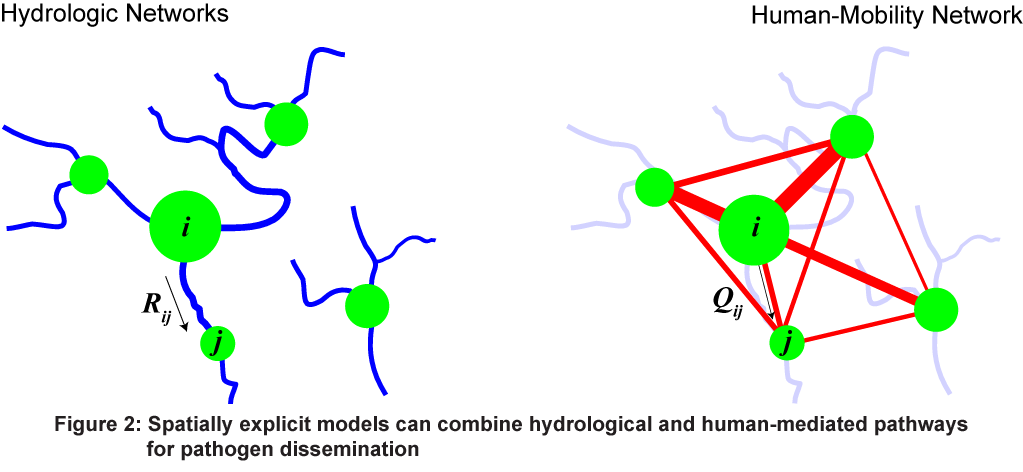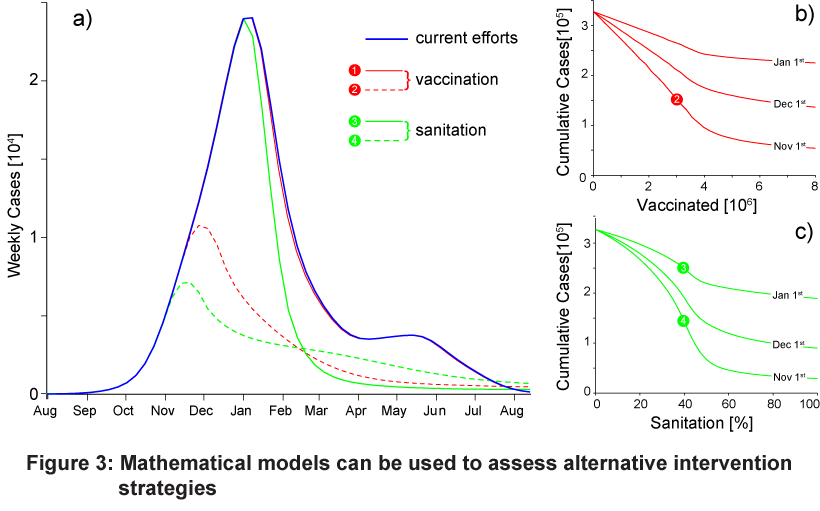
DYCHO is an interdisciplinary project focusing on large-scale cholera epidemic modelling and its use for emergency management of control measures. Its domain (i.e. bringing mathematical modelling into mainstream epidemiology) is perceived to be a key research field for years to come. Its relevance, with the implied capabilities of predicting the space-time evolution of infections (including the instantaneous local values of severely/asymptomatic infected or susceptible individuals) is crucial to public health and intervention strategy management, as it allows a sensible design of the deployment of life-saving medical supplies and staff, and optimization of control measures like mass vaccinations, extended use of antibiotics and its drawbacks, sanitation improvement resulting in reduced exposure rates and access to clean drinking supplies, mobility restrictions etc. The milestones of the project imply the creation and application of a new generation of spatially explicit models of cholera epidemics that include: i) improved transmission models, e.g. for spatial connectivity owing to both waterways and human-mobility-induced pathogen dispersal; ii) deeper understanding of the ecology of the Vibrio cholerae bacterium; iii) the development of predictive and management tools, including cost-effectiveness and pedagogical studies to evaluate optimal intervention strategies during an outbreak on the basis of projected infection figures; and iv) linking models and epidemiological field studies. Much of the research carried out within  the project DYCHO deals with interdisciplinary developments. Specifically, these concern: i) refined modeling of transmission dynamics of the emerging infectious disease (e.g. hydrologic and human mobility factors) regarding both intra- and inter-populations dynamics; ii) dominant human mobility patterns, as they constitute a key (and often neglected) driver of the spreading of pathogens (for instance, through the mobility of asymptomatic infected individuals or susceptibles); iii) the crucial linkage of these models to cost effectiveness analyses to quantitatively evaluate the impact of intervention strategies in space and time (e.g. given a fixed amount of vaccination doses, design the best distribution strategy); iv) deeper predictive capabilities to describe the ecology of Vibrio cholerae and its natural transformations, needed to improve transmission models. DYCHO aims at tackling the above aspects also by suitably planning model-guided field validations.
the project DYCHO deals with interdisciplinary developments. Specifically, these concern: i) refined modeling of transmission dynamics of the emerging infectious disease (e.g. hydrologic and human mobility factors) regarding both intra- and inter-populations dynamics; ii) dominant human mobility patterns, as they constitute a key (and often neglected) driver of the spreading of pathogens (for instance, through the mobility of asymptomatic infected individuals or susceptibles); iii) the crucial linkage of these models to cost effectiveness analyses to quantitatively evaluate the impact of intervention strategies in space and time (e.g. given a fixed amount of vaccination doses, design the best distribution strategy); iv) deeper predictive capabilities to describe the ecology of Vibrio cholerae and its natural transformations, needed to improve transmission models. DYCHO aims at tackling the above aspects also by suitably planning model-guided field validations.

Video:
 Un modèle mathématique pour combattre le choléra: le point avec Flavio Finger à Lausanne. RTS.ch
Un modèle mathématique pour combattre le choléra: le point avec Flavio Finger à Lausanne. RTS.ch
Relevant publications:
- On the probability of extinction of the Haiti cholera epidemic, in Stochastic Environmental Research and Risk Assessment.
- Mobile phone data highlights the role of mass gatherings in the spreading of cholera outbreaks.
- On the predictive ability of mechanistic models for the Haitian cholera epidemic.
- Glucose- but Not Rice-Based Oral Rehydration Therapy Enhances the Production of Virulence Determinants in the Human Pathogen Vibrio cholerae.
- Cholera in the Lake Kivu region (DRC): Integrating remote sensing and spatially explicit epidemiological modeling
Period : 2011-2017
 PhD : D. Pasetto —
PhD : D. Pasetto — Prof. A. Rinaldo
Prof. A. Rinaldo External collaborators :  AP. M. Bierlaire — Prof. M. Blokesch — C-L Chaignat — Prof. M. Gatto — S.M. Islam — AP. M. Murray — Prof. I. Rodriguez-Iturbe
AP. M. Bierlaire — Prof. M. Blokesch — C-L Chaignat — Prof. M. Gatto — S.M. Islam — AP. M. Murray — Prof. I. Rodriguez-Iturbe